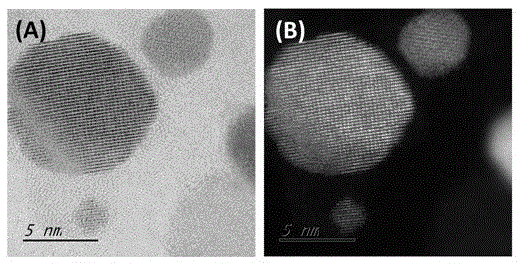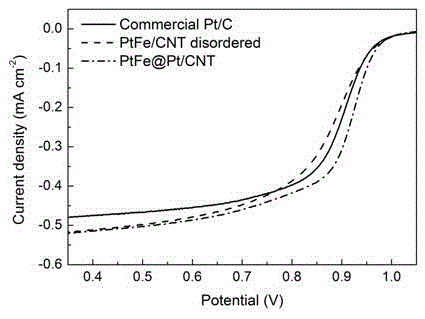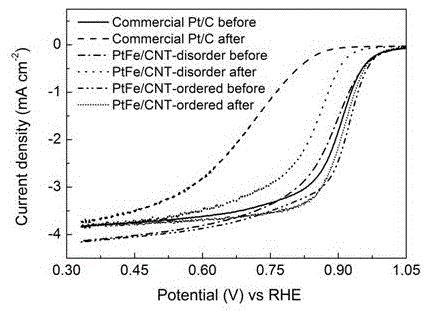Carbon-nanotube-loaded platinum-iron superlattice alloy nanoparticles and preparation method therefor
A technology of alloy nanoparticles and carbon nanotubes, applied in nanotechnology, nanotechnology, nanotechnology for materials and surface science, etc., can solve problems such as difficult application and low catalytic stability, and achieve improved activity and stability. , The effect of simple equipment process and safe operation
- Summary
- Abstract
- Description
- Claims
- Application Information
AI Technical Summary
Problems solved by technology
Method used
Image
Examples
Embodiment 1
[0026] 1) Mix 150mL of concentrated sulfuric acid and 50mL of concentrated nitric acid, add 1g of carbon nanotubes into the mixed acid, heat to 70°C under stirring, and react for 5 hours;
[0027] 2) Slowly add the mixed solution after the reaction in step 1) into 1000mL deionized water under stirring conditions, separate the solid and liquid components by suction filtration, and dry the solid in a vacuum oven at 60°C for 12 hours to obtain acidified carbon nanotube;
[0028] 3) Take 50 mg of acidified carbon nanotubes obtained in step 2), put them in a three-necked flask, add 100 mL of ethylene glycol, and ultrasonically disperse for 30 minutes, dissolve 33.5 mg of chloroplatinic acid and 12 mg of ferrous nitrate in the above dispersed carbon In the ethylene glycol of nanotubes, continue to sonicate for 30 minutes to mix evenly;
[0029] 4) Heat the mixed solution in step 3) to 80°C under stirring, add 500mL, 0.1mol / L sodium borohydride aqueous solution, and keep heating to ...
Embodiment 2
[0034] 1) Mix 120mL of concentrated sulfuric acid and 40mL of concentrated nitric acid, add 0.8g of carbon nanotubes into the mixed acid, heat to 60°C under stirring, and react for 10 hours;
[0035] 2) Slowly add the mixed liquid after the reaction in step 1) into 1000mL deionized water under stirring conditions, separate the solid and liquid components by suction filtration, and dry the solid in a vacuum oven at 80°C for 10 hours to obtain acidified carbon nanotube;
[0036] 3) Take 80 mg of acidified carbon nanotubes obtained in step 2), put them in a three-necked flask, add 150 mL of ethylene glycol, and ultrasonically disperse for 30 minutes, dissolve 38.6 mg of chloroplatinic acid and 15.2 mg of ferrous nitrate in the above dispersed solution In the ethylene glycol of carbon nanotubes, continue to sonicate for 30 minutes to mix evenly;
[0037] 4) Heat the mixed solution in step 3) to 80°C under stirring, add 300mL, 0.1mol / L sodium borohydride aqueous solution, and keep...
PUM
| Property | Measurement | Unit |
|---|---|---|
| particle diameter | aaaaa | aaaaa |
| particle size | aaaaa | aaaaa |
| particle size | aaaaa | aaaaa |
Abstract
Description
Claims
Application Information
 Login to View More
Login to View More - R&D
- Intellectual Property
- Life Sciences
- Materials
- Tech Scout
- Unparalleled Data Quality
- Higher Quality Content
- 60% Fewer Hallucinations
Browse by: Latest US Patents, China's latest patents, Technical Efficacy Thesaurus, Application Domain, Technology Topic, Popular Technical Reports.
© 2025 PatSnap. All rights reserved.Legal|Privacy policy|Modern Slavery Act Transparency Statement|Sitemap|About US| Contact US: help@patsnap.com



